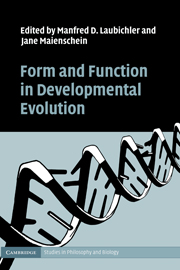Book contents
- Frontmatter
- Contents
- List of figures
- List of tables
- List of contributors
- List of journal abbreviations
- 1 Introduction
- 2 Form and function in Evo Devo: historical and conceptual reflections
- 3 Deducing plant function from organic form: challenges and pitfalls
- 4 Evolution in the light of embryos: seeking the origins of novelties in ontogeny
- 5 A focus on both form and function in examining selection versus constraint
- 6 Innovation and diversity in functional morphology
- 7 The developmental evolution of avian digit homology: an update
- 8 Functional analysis and character transformation
- 9 The nature of constraints
- 10 Toward a mechanistic Evo Devo
- Index
- References
8 - Functional analysis and character transformation
Published online by Cambridge University Press: 28 June 2009
- Frontmatter
- Contents
- List of figures
- List of tables
- List of contributors
- List of journal abbreviations
- 1 Introduction
- 2 Form and function in Evo Devo: historical and conceptual reflections
- 3 Deducing plant function from organic form: challenges and pitfalls
- 4 Evolution in the light of embryos: seeking the origins of novelties in ontogeny
- 5 A focus on both form and function in examining selection versus constraint
- 6 Innovation and diversity in functional morphology
- 7 The developmental evolution of avian digit homology: an update
- 8 Functional analysis and character transformation
- 9 The nature of constraints
- 10 Toward a mechanistic Evo Devo
- Index
- References
Summary
INTRODUCTION: PATTERN AND PROCESS
It is widely recognized that Darwin's theory of evolution incorporates, first, a historical “pattern” component asserting that species originated by divergent transformation from common ancestry, and that the similarities and differences among species reflect that pattern; and second, a “process” component asserting that this transformation occurs largely (but not exclusively) by the mechanism of natural selection. Given that these evolutionary patterns are products of evolutionary processes, it is unsurprising that systematists have traditionally relied on assumptions about process to reconstruct patterns of evolutionary transformation. But this use of process assumptions has been a source of dispute among systematists. Traditional “evolutionary systematists” have explicitly and systematically relied on process assumptions, while “cladists” have typically rejected the use of assumptions, on charges of circularity: if process assumptions are used to reconstruct evolutionary history, they can only be trivially confirmed by that reconstruction.
The primary focus of cladists' criticism has been functional analysis. The basic idea behind functional analysis is that once we understand how characters function, we can infer the operation of natural selection. And from that we can infer the likely directions of transformation, which can then be used to reconstruct the phylogenetic relationships of biological taxa. Cladists typically reject functional analysis, arguing that we should instead reconstruct evolutionary history on the basis of a theoretically neutral parsimony principle. It is not possible here to give a detailed account of the full range of the debate over functional analysis.
- Type
- Chapter
- Information
- Form and Function in Developmental Evolution , pp. 176 - 200Publisher: Cambridge University PressPrint publication year: 2009



